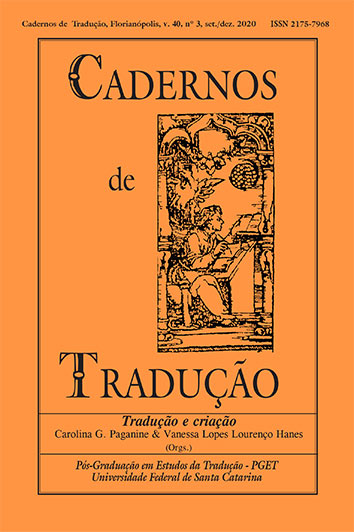Tradução, diálogo, testemunho: primo Levi e seus tradutores
DOI:
https://doi.org/10.5007/2175-7968.2020v40n3p75Abstract
A aventura das numerosas traduções de textos do escritor italiano Primo Levi (1919-1987), sobrevivente de Auschwitz, mas também reconhecido como um grande narrador do século XX, aponta para a importância de uma leitura atenta, competente das questões testemunhais e literárias, capaz de se colocar numa dimensão relacional. Se o ato tradutório pode ser abordado como relação entre textos (Meschonnic) - e não apenas entre línguas -, a solução de impasses ou o enriquecimento que advém da soma do original com seu texto traduzido pode se dar também graças a relações pessoais e de intensa escuta entre escritor e tradutor, ou, se quisermos usar uma expressão ao mesmo tempo química e literária, graças às afinidades eletivas instauradas na leitura (e releitura operada por ambos). Interessantes casos das traduções inglesa e alemã do primeiro texto de Levi, Se questo è un uomo (1947/ 2 ed.1958), serão relatados para compor um quadro panorâmico de sucessos e problemáticas, mas também para introduzir a questão específica da tradução brasileira do livro (editora Rocco, 1988), seus limites e potenciais desafios futuros.
Literaturhinweise
Basevi, Anna. “O tradutor como testemunha.”. Cadernos de Tradução. 38.3, (2018): 226-243. DOI: https://doi.org/10.5007/2175-7968.2018v38n3p226. Portal de Periódicos da UFSC. 20/01/2020. Disponível em: https://periodicos.ufsc.br/index.php/traducao/article/view/2175-7968.2018v38n3p226.
Belpoliti, Marco. Primo Levi, di fronte e di profilo. Milano: Guanda, 2015.
Berman, Antoine, A tradução e a letra ou o Albergue do longínquo. Tradução de Marie-Hélène Torres, Mauri Furlan e Andréia Guerini Florianópolis: PGET/UFSC, 2013.
Ferrero, Ernesto. Primo Levi. La vita, le opere.Torino: Einaudi, 2007.
Gagnebin, Jeanne Marie (a). Lembrar, escrever, esquecer. SãoPaulo: Editora 34, 2006.
Gagnebin, Jeanne Marie (b). “Prefácio a Giorgio Agamben, ”. O que resta de Auschwitz, Giorgio Agamben (org). São Paulo: Boitempo editorial, 2008, p.9-17.
Goldstein, Ann. “Quattro giovani soldati”. In un´altra lingua. (Lezione Primo Levi), Ann Goldstein; Domenico Scarpa (orgs). Torino: Einaudi, 2015, p.3-36.
Insana, Lina N. Ardous tasks. Primo Levi, translation and the transmission of holocaust testimony. Toronto: University of Toronto Press Incorporated, 2009
Klemperer, Victor. LTI. A língua do Terceiro Reich. Rio de Janeiro: Contraponto, 2009.
Levi, Primo (a). É isto um homem? Tradução de Luigi Del Re. Rio de Janeiro: Rocco, 1988.
Levi, Primo (b). A tabela periódica. Tradução de Luis Sérgio Henriques. Rio de Janeiro: Relume-Dumará, 1994.
Levi, Primo (c). Os afogados e os sobreviventes. Tradução de Luis Sérgio Henriques. São Paulo: Paz e terra, 2004.
Levi, Primo (d). 71 contos de Primo Levi. Tradução de Maurício Santana Dias. São Paulo: Companhia das Letras, 2005.
Levi, Primo (e). Se questo è un uomo. (Notas de Alberto Cavaglion).Torino: Einaudi, 2012.
Levi, Primo; Riedt, Heinz. Letters Primo Levi-Heinz Riedt. Ian Thomson collection, fasc.1406/2/22, Wiener Library, London.
Meschonnic, Henri. Poétique du traduire. Paris, Verdier, 1999.
Scarpa, Domenico. “Leggere in italiano, ricopiare in inglese.”. In un´altra lingua, (Lezione Primo Levi), Ann Goldstein; Domenico Scarpa (orgs). Torino: Einaudi, 2015, p.37-152.
Segre, Cesare. Lettura di “Se questo è un uomo”, Primo Levi: Un´antologia della critica. Ferrero, Ernesto (Org.), Torino: Einaudi, 1997, p. 55-75.
Downloads
Veröffentlicht
Zitationsvorschlag
Ausgabe
Rubrik
Lizenz
Autores têm autorização para assumir contratos adicionais separadamente, para distribuição não exclusiva da versão do trabalho publicada nesta revista (ex.: publicar em repositório institucional ou como capítulo de livro, com reconhecimento de autoria e publicação inicial nesta revista).





















































